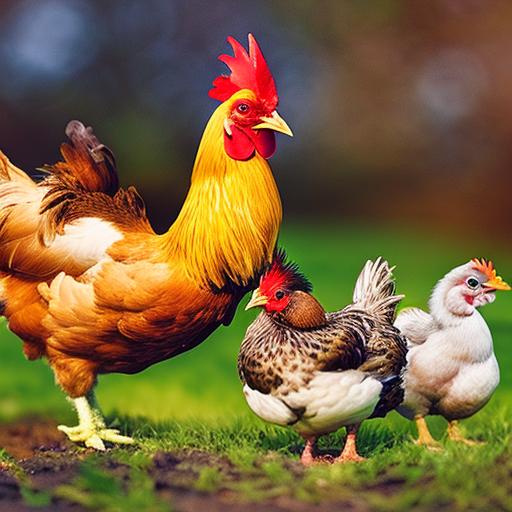Keeping chickens healthy and comfortable is essential for their overall well-being. As a chicken owner, it is your responsibility to provide them with a suitable environment that meets their needs. Temperature control is a crucial aspect of chicken care, as chickens are sensitive to extreme temperatures. In this blog post, we will discuss the ideal temperature range for chickens, factors that affect their comfort and health, and heating and cooling solutions for chicken coops.
Key Takeaways
- Temperature control is crucial for the health and comfort of chickens.
- The ideal temperature range for chickens is between 50-80°F.
- Factors such as humidity, ventilation, and insulation can affect chicken comfort and health.
- Proper ventilation is essential for maintaining optimal temperature in the coop.
- Heating and cooling solutions, as well as monitoring temperature and humidity levels, are key to regulating temperature in the coop.
Ideal Temperature Range for Chickens
Chickens are comfortable in a temperature range of 50-80°F (10-27°C). Temperatures above 90°F (32°C) or below 40°F (4°C) can be dangerous for chickens and can lead to heat stress or hypothermia. It is important to maintain a consistent temperature in the coop to ensure the well-being of your flock.
Factors that Affect Chicken Comfort and Health
Several factors can affect the comfort and health of chickens in relation to temperature control. One such factor is humidity levels. High humidity can make it difficult for chickens to regulate their body temperature, leading to heat stress. On the other hand, low humidity can cause respiratory issues and dry out the chicken’s respiratory system.
Drafts are another factor that can impact chicken comfort. Drafts can cause chickens to become chilled, especially during colder months. It is important to ensure that the coop is well-insulated and free from any drafts.
Overcrowding is also a factor that can affect chicken comfort and health in relation to temperature control. When chickens are overcrowded, they generate more body heat, which can lead to stress and discomfort. It is important to provide enough space for your flock to move around freely and avoid overcrowding.
The Role of Ventilation in Maintaining Optimal Temperature
Proper ventilation is essential for maintaining a healthy environment for chickens. Ventilation helps regulate temperature and humidity levels in the coop. It allows fresh air to circulate and removes stale air, moisture, and odors. Good ventilation also helps prevent the buildup of harmful gases such as ammonia.
It is important to balance ventilation with insulation to maintain a consistent temperature. While ventilation is necessary, excessive drafts can be detrimental to the health of your chickens. Properly designed vents and windows can help maintain a healthy airflow without causing drafts.
Heating and Cooling Solutions for Chicken Coops
Heating solutions can be used during colder months to keep the coop warm and comfortable for chickens. Heat lamps, radiant heaters, and heated waterers are commonly used heating solutions. Heat lamps provide direct heat and can be hung from the ceiling of the coop. Radiant heaters are installed on the walls or ceiling and emit heat in a specific direction. Heated waterers prevent the water from freezing during winter.
Cooling solutions are essential during hot summer months to prevent heat stress in chickens. Fans, misters, and shade cloth are commonly used cooling solutions. Fans help circulate air and provide a cooling effect. Mist systems spray a fine mist of water into the air, which evaporates and cools down the surrounding area. Shade cloth can be used to provide shade and reduce the temperature inside the coop.
It is important to choose the right heating or cooling solution for your climate and coop size. Consider factors such as energy efficiency, safety, and ease of use when selecting a solution for your chicken coop.
Tips for Insulating Your Chicken Coop

Insulation plays a crucial role in maintaining a consistent temperature inside the chicken coop and reducing energy costs. Common insulation materials include fiberglass, foam board, and reflective foil.
Fiberglass insulation is easy to install and provides good thermal resistance. It is important to wear protective clothing, gloves, and a mask when handling fiberglass insulation to avoid skin irritation and respiratory issues.
Foam board insulation is another popular option for chicken coops. It is lightweight, easy to cut, and provides excellent insulation. Foam board insulation can be installed on the walls, ceiling, and floor of the coop.
Reflective foil insulation is effective in reducing heat transfer. It reflects radiant heat away from the coop, keeping it cooler during hot summer months. Reflective foil insulation can be installed on the walls and roof of the coop.
It is important to seal any gaps or cracks in the coop to prevent drafts. Use caulk or weatherstripping to seal gaps around windows, doors, and vents. This will help maintain a consistent temperature inside the coop and prevent heat loss during colder months.
The Importance of Monitoring Temperature and Humidity Levels
Regularly monitoring temperature and humidity levels in the chicken coop is essential for maintaining a healthy environment for your flock. Fluctuations in temperature and humidity can lead to health issues such as respiratory problems and heat stress.
Digital thermometers and hygrometers are useful tools for monitoring temperature and humidity levels. Place them in different areas of the coop to get an accurate reading of the overall conditions. It is important to check these levels regularly and make adjustments as needed.
How to Adjust Temperature in Your Chicken Coop
Adjusting the temperature in your chicken coop can be done by adjusting ventilation, adding or removing insulation, or using heating or cooling solutions. If the coop is too hot, increase ventilation by opening windows or installing additional vents. If the coop is too cold, close windows and vents to reduce drafts and consider adding insulation or using heating solutions.
It is important to make gradual adjustments to avoid stressing chickens. Sudden changes in temperature can be detrimental to their health. Monitor their behavior and adjust accordingly until you find the optimal temperature for your flock.
Common Mistakes to Avoid When Regulating Temperature
When regulating temperature in the chicken coop, there are some common mistakes that should be avoided. Overheating or overcooling the coop can be dangerous for chickens. It is important to maintain a temperature within the ideal range and avoid extreme temperatures.
Using the wrong heating or cooling solution for your climate can be ineffective or even harmful. Consider the specific needs of your flock and the climate in your area when selecting heating or cooling solutions for your coop.
Neglecting to monitor temperature and humidity levels can lead to health issues in chickens. Regularly check these levels and make adjustments as needed to ensure the well-being of your flock.
Ensuring Your Chickens Thrive in the Right Temperature
Temperature control is a crucial aspect of chicken care. By understanding the ideal temperature range for chickens, factors that affect their comfort and health, and heating and cooling solutions for chicken coops, you can ensure that your chickens thrive in the right temperature.
Regularly monitoring temperature and humidity levels and making gradual adjustments as needed can help keep your chickens healthy and comfortable. Providing proper ventilation, insulation, and using appropriate heating or cooling solutions will create a suitable environment for your flock.
Remember to consider the specific needs of your flock and the climate in your area when implementing temperature control measures. With proper temperature control, you can ensure that your chickens are happy, healthy, and thriving.
If you’re interested in learning more about the best temperature for keeping chickens, you might also find this article on chicken coop nest boxes helpful. It provides valuable insights on how to create a comfortable and suitable environment for your chickens, including tips on temperature control. Check it out here.
FAQs
What is the best temperature for keeping chickens?
The ideal temperature for chickens is between 50-80°F (10-27°C).
What happens if the temperature is too hot for chickens?
If the temperature is too hot, chickens can suffer from heat stress, which can lead to dehydration, decreased egg production, and even death.
What happens if the temperature is too cold for chickens?
If the temperature is too cold, chickens can suffer from frostbite, respiratory problems, and decreased egg production.
How can I regulate the temperature for my chickens?
You can regulate the temperature for your chickens by providing proper ventilation, shade, and access to water. You can also use heat lamps or heaters during cold weather.
What are some signs that my chickens are too hot or too cold?
Signs that your chickens are too hot include panting, holding their wings away from their body, and decreased egg production. Signs that your chickens are too cold include huddling together, shivering, and decreased egg production.
Can chickens adapt to different temperatures?
Chickens can adapt to different temperatures, but sudden changes in temperature can be stressful for them. It’s best to gradually acclimate them to new temperatures.
Meet Walter, the feathered-friend fanatic of Florida! Nestled in the sunshine state, Walter struts through life with his feathered companions, clucking his way to happiness. With a coop that’s fancier than a five-star hotel, he’s the Don Juan of the chicken world. When he’s not teaching his hens to do the cha-cha, you’ll find him in a heated debate with his prized rooster, Sir Clucks-a-Lot. Walter’s poultry passion is no yolk; he’s the sunny-side-up guy you never knew you needed in your flock of friends!







